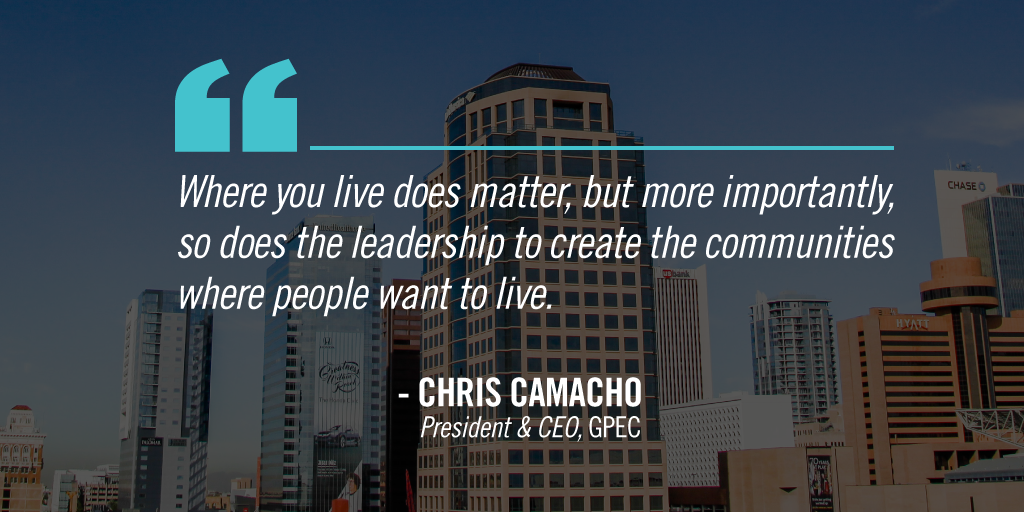

You’re only as successful as your neighbors
Published: 02/01/2018
Updated: 02/28/2022
By GPEC President & CEO, Chris Camacho
In 1920 when Gilbert, Arizona became a city, it was known as the hay capital of the world. Today, it is one of the fastest growing communities in the United States, with a population surpassing 230,000 people and growing. In the 2017 Distressed Communities Index, released by the Economic Innovation Group this fall, Gilbert was ranked as the number one most prosperous community in the country.
Nearby communities Chandler and Scottsdale were also at the top of the list, coming in as seventh and tenth most prosperous cities respectively. With three cities in Arizona in the top 10, only Texas had as many communities on the list, which examined a number of factors that differentiates a prosperous community from a distressed one.
Factors such as education, housing vacancy rates, number of adults working, poverty rate, median income ratio, and change in employment and change in business establishments were all measured to assess the vitality of communities in the U.S.
While the data was promising for the Greater Phoenix region, the outlook for other parts of the state were not. This disconnect between prosperity and distress is not unique to Arizona, and something that is occurring across the entirety of the U.S. Bottom line is, where you live matters in today’s economy.
When businesses are looking to expand, they look to communities like those on the top of the most prosperous list, and often turn away from giving consideration to those on the top of the most distressed communities list, furthering the divide. Further complicating matters, another report from EIG released in the spring examined economic dynamism across the country, revealing that five metro markets “produced as big of an increase in businesses as the rest of the nation combined.”
During the 1980 presidential election, then-candidate Ronald Reagan explained economic downturns simply as “a recession is when your neighbor loses his job, a depression is when you lose yours.” In that vein, is our success to be celebrated when our neighbors are losing jobs?
In the 1980s, the increase in the number of businesses nationwide was nearly half a million. Yet, in the decades since, these numbers have declined, with the most dramatic reduction occurring post-recession, when barely more than 100,000 new businesses formed between 2010 and 2014, and companies were dying off faster than they were being created.
These statistics beg the question – did the recession create an insecurity amongst entrepreneurs and innovators? Fortunately, pitch competitions across the US targeted at spurring innovation and creativity are encouraging people to bring forward new ideas, and gain access to capital to spur new businesses. In Arizona for example, the state offers the Arizona Innovation Challenge, where awards are given each year to six innovative companies who receive awards ranging from $100,000 to $250,000.
The Rise of the Rest competition, led by Steve Case – the founder of AOL and driver behind the national multi-city bus tour – hands out $100,000 checks to the best pitch in cities across the country. But in what could called the biggest commitment to supporting business formation, earlier this month Rise of the Rest announced a new $150 million fund that will focus on investing in startups in “so-called flyover states.” So far, the fund is backed by the who’s who of business, including Jeff Bezos, Howard Schultz, Dan Gilbert, Sara Blakely, and the Waltons, among others.
Locally, in Greater Phoenix there are more than 40 co-working spaces, maker spaces and incubators, with operations across the region that each offer a unique asset to entrepreneurs and startups. The Center for Entrepreneurship and Innovation, for example, is a full-service business incubator supporting emerging technology startups. Last month, the second Arizona Cyber Warfare Range opened its doors through a partnership with Grand Canyon University, and early next month a new co-working space for women, Thrive, will open its doors.
The regions that do more to support business formation and new innovation in their markets will continue to differentiate themselves. Hopefully, more leaders will support such efforts to lessen the growing divide that separates the underperforming communities from those that are flourishing. Where you live does matter, but more importantly, so does the leadership to create the communities where people want to live.
